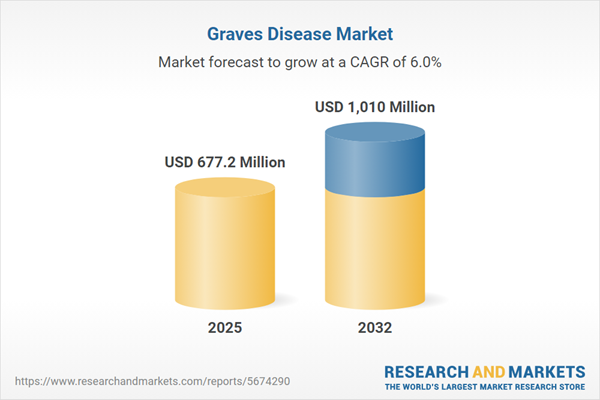Speak directly to the analyst to clarify any post sales queries you may have.
The Graves Disease Market is evolving rapidly as healthcare systems prioritize enhanced diagnostics, targeted therapies, and resilient supply chains to address growing demands and complex care requirements. Senior executives require clear, actionable insights to navigate this dynamic space and maximize strategic opportunities.
Market Snapshot: Growth Trajectory and Competitive Landscape
The Graves Disease Market grew from USD 641.22 million in 2024 to USD 677.20 million in 2025. It is expected to continue growing at a CAGR of 5.97%, reaching USD 1.01 billion by 2032. This expansion is propelled by advances in precision diagnostics, immunomodulatory therapies, and digital health integration. Key pharmaceutical and diagnostic companies are refining their innovation pipelines and forging alliances to adapt to shifting market needs, regulatory changes, and regional disparities.
Scope & Segmentation
This research provides a comprehensive analysis of the Graves Disease Market, examining trends and developments across core categories, regions, and organizations:
- Diagnosis: Blood tests (measuring Free T4 & T3 Levels, Thyroid-stimulating Hormone Levels, TSH Receptor Antibodies), imaging tests (Radioactive Iodine Uptake, Thyroid Ultrasound), and physical examination.
- Treatment Type: Antithyroid medications, beta-blockers, and radioactive iodine therapy.
- Age Group: Insights for adult, elderly, and pediatric populations inform care pathways and risk management strategies.
- Route Of Administration: Intravenous and oral approaches to optimize chronic and acute care delivery.
- Distribution Channel: Hospital pharmacies, online pharmacies, and retail pharmacies reinforce medication and diagnostic accessibility.
- Geographic Regions: Americas (United States, Canada, Mexico, Brazil, Argentina, Chile, Colombia, Peru), Europe, Middle East & Africa (United Kingdom, Germany, France, Russia, Italy, Spain, Netherlands, Sweden, Poland, Switzerland, United Arab Emirates, Saudi Arabia, Qatar, Turkey, Israel, South Africa, Nigeria, Egypt, Kenya), and Asia-Pacific (China, India, Japan, Australia, South Korea, Indonesia, Thailand, Malaysia, Singapore, Taiwan).
- Company Analysis: Coverage includes major pharmaceutical and diagnostic leaders such as Abbott Laboratories, Merck KGaA, Novartis AG, Pfizer Inc., Siemens Healthineers AG, Thermo Fisher Scientific Inc., and regional players such as Macleods Pharmaceuticals Ltd. and Wellona Pharma.
Key Takeaways for Senior Decision-Makers
- Advancement in molecular diagnostics and biomarker discovery is enabling more accurate and timely diagnosis, supporting earlier intervention and patient stratification.
- Shifts toward personalized immunomodulatory treatments and the integration of telemedicine platforms are improving patient management, especially in remote or underserved areas.
- Regional disparities highlight the importance of tailored approaches; while North America and Western Europe leverage robust infrastructure, emerging markets are focusing on expanding diagnostic capabilities and digital health ecosystems.
- Strategic collaborations between pharmaceutical and diagnostic companies facilitate the co-development of innovative therapies and companion diagnostics, reducing product launch hurdles and enhancing commercialization efficiency.
- Supply chain resilience has become paramount, as recent tariff changes and geopolitical events have prompted organizations to diversify sourcing, develop regional manufacturing partnerships, and invest in scenario planning for procurement continuity.
Tariff Impact: Shaping Supply Chain Strategies
Recent United States tariff policies have led to higher costs for importing diagnostic reagents and active pharmaceutical ingredients, influencing vendor partnerships and procurement tactics. Firms are responding by exploring domestic manufacturing, alternative sourcing, and collaboration with contract manufacturers in allied markets. These actions bolster operational agility and safeguard diagnostic and treatment pathways against further disruptions.
Methodology & Data Sources
This analysis draws on exhaustive secondary research covering scientific literature, regulatory filings, and clinical practice guidelines, augmented by direct input from endocrinologists, laboratory directors, and industry advisers. Continuous validation and triangulation of data ensure accuracy and strategic depth.
The Importance of This Graves Disease Market Report
- Guides executive decisions on investments in diagnostics, therapeutics, and supply chain resilience by aligning insights with the latest regulatory and technology trends.
- Supports stakeholder initiatives to enhance treatment reach, improve patient outcomes, and establish effective collaborations in key regions and segments.
Conclusion
This report delivers clear guidance and actionable intelligence for senior leaders seeking to address evolving clinical demands and navigate the complexities of the Graves Disease Market. Use these insights to strengthen strategic positioning and deliver superior care solutions.
Additional Product Information:
- Purchase of this report includes 1 year online access with quarterly updates.
- This report can be updated on request. Please contact our Customer Experience team using the Ask a Question widget on our website.
Table of Contents
3. Executive Summary
4. Market Overview
7. Cumulative Impact of Artificial Intelligence 2025
Companies Mentioned
The companies profiled in this Graves Disease market report include:- Abbott Laboratories
- AdvanceCor GmbH
- Cadila Pharmaceuticals Limited
- CORONA Remedies Limited
- Daxia Healthcare Pvt Ltd.
- Eris Lifesciences Ltd
- F. Hoffmann-La Roche Ltd.
- Immunovant, Inc. by Roivant Sciences Ltd.
- LGM Pharma
- Macleods Pharmaceuticals Ltd.
- Merck KGaA
- Novartis AG
- Pfizer Inc.
- Salvavidas Pharmaceutical Pvt. Ltd.
- Siemens Healthineers AG
- Steris Healthcare Pvt Ltd
- Sun Pharmaceutical Industries Ltd
- Synmedic Laboratories by Dhanuka Laboratories Limited
- Teva Pharmaceutical Industries Ltd.
- Thermo Fisher Scientific Inc.
- Wellona Pharma
Table Information
| Report Attribute | Details |
|---|---|
| No. of Pages | 196 |
| Published | November 2025 |
| Forecast Period | 2025 - 2032 |
| Estimated Market Value ( USD | $ 677.2 Million |
| Forecasted Market Value ( USD | $ 1010 Million |
| Compound Annual Growth Rate | 5.9% |
| Regions Covered | Global |
| No. of Companies Mentioned | 22 |









